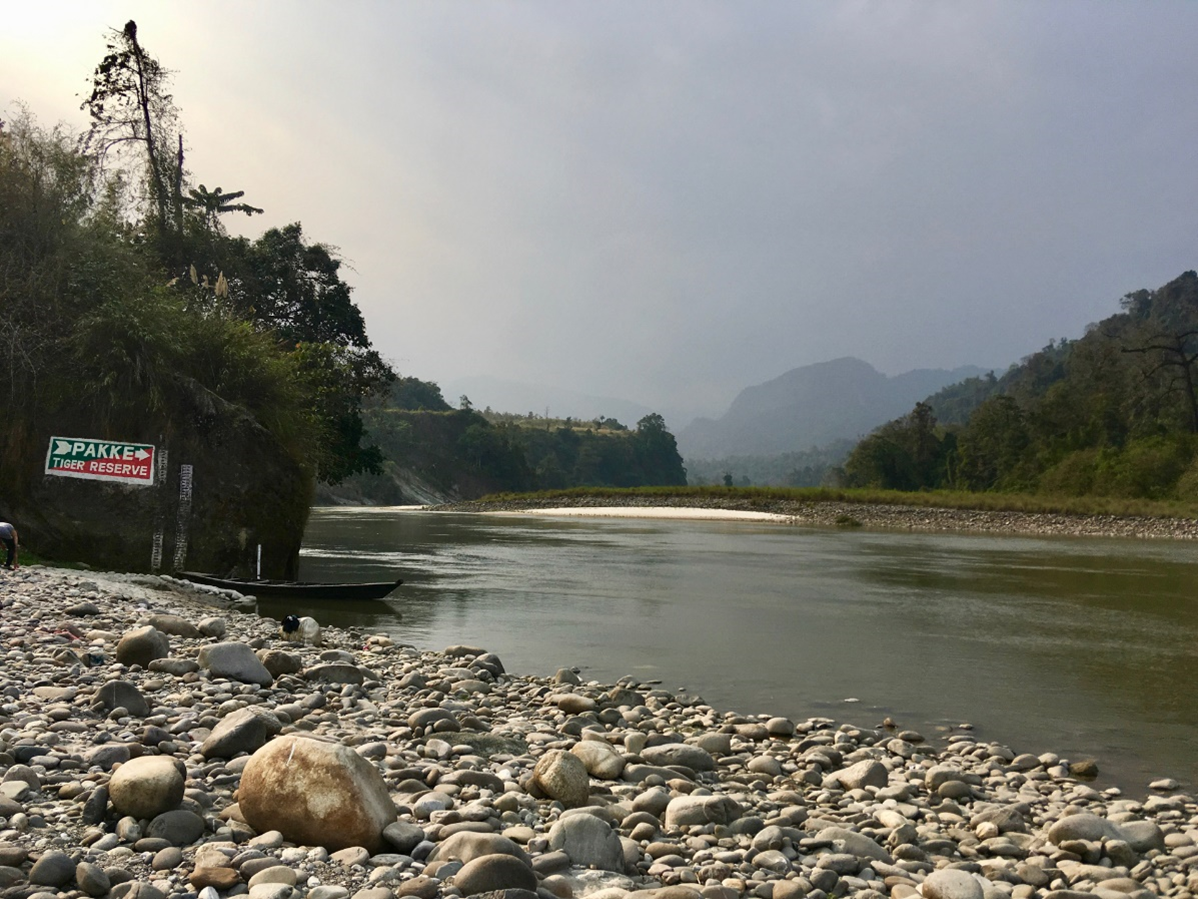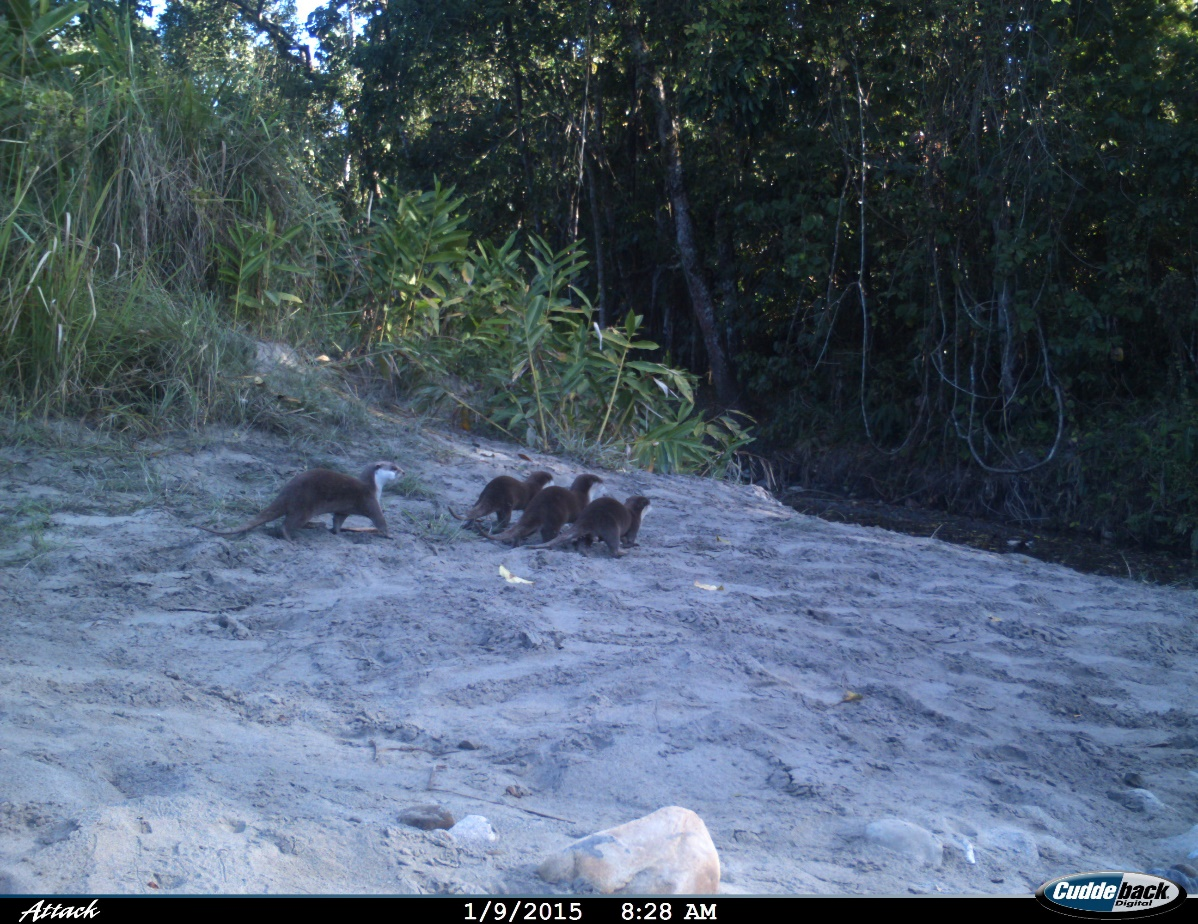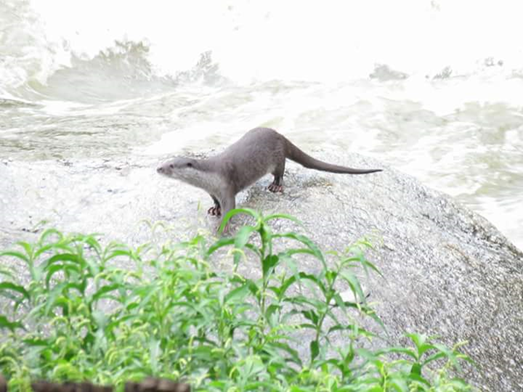IUCN/SSC Otter Specialist Group Bulletin

©IUCN/SCC Otter Specialist Group
Volume 39 Issue 1 (February 2022)
Citation: Borker, A., Gogi, K., Krupa, H., Savage, M. and Bhardwaj, N. (2022). Otter Survey in Pakke Tiger Reserve, Arunachal Pradesh, Eastern Himalayas of India. IUCN Otter Spec. Group Bull. 39 (1): 29 - 38
Otter Survey in Pakke Tiger Reserve, Arunachal Pradesh, Eastern Himalayas of India
Atul Borker1*, Komal Gogi1, Hannah Krupa2, Melissa Savage3, and Nishant Bhardwaj1*
1Luta Innovation, Goa, India 403501
2Department of Biosciences and Territory, University of Molise, Pesche, Italy
3University of California Los Angeles, Los Angeles, CA 90024
*Corresponding Author Email: borker.atul@gmail.com
(Received 19th April 2021, accepted 8th September 2021)
Abstract:Otter species are declining across their distribution in South Asia. There is an urgent need to understand the distribution of otters in the region, as well as to direct conservation efforts and protect their habitat. In India, there are very few data on otters in the Northeast region of the country. In this study, we report the presence of two species, Eurasian and Small-clawed otters, in the Pakke Tiger Reserve and Wildlife Sanctuary (Pakke Tiger Reserve) in Arunachal Pradesh, a large Indian state in the Eastern Himalayas. The Eurasian otter and the Small-clawed otter species are listed on Appendix I of CITES and are protected by Wildlife (Protection) Act 1972 in India. We conducted the first survey for otters in the Indian North-east, along the Kameng River, and recorded 43 otter signs, 23 of the Eurasian otter, and 20 of the Small-clawed otter, and retrieved photographic records of both species. There is an urgent need for further research and the development of conservation strategies to protect otters in the region.
Keywords: Eurasian otter, Lutra lutra, Small-clawed otter, Aonyx cinereus, Pakke Tiger Reserve, Eastern Himalayas
INTRODUCTION
The Indian subcontinent is home to three species of otter, the Small-clawed otter Aonyx cinereus, the Eurasian otter Lutra lutra, and the Smooth-coated otter Lutrogaleperspicillata (Hussain, 1999). Almost nothing is known about their distribution or status in the Arunachal Pradesh, a remote state of India in the Eastern Himalayas. Among the three species, recent records of the Eurasian otter in the region are the sparsest. Only recently have there been confirmed reports of Eurasian otters in other parts of India (e.g., Conroy et al., 1998; Joshi et al., 2016; Jamwal et al., 2016). In this study, we report evidence of two otter species, the Eurasian otter and Small-clawed otter along the Kameng River in Arunachal Pradesh, based on a field survey and photographic records.
The terrain of Arunachal Pradesh is highly rugged, with steep mountains, deep gorges and an elevational gradient of 100 to 5500 m. It lies in the eastern ranges of the Himalayas, and is bordered by Bhutan to the east, China to the north, and Myanmar to the east. The main rivers, fed by high elevation glaciers, flow on a precipitous gradient from north to south, and include the Kameng, Lohiti, Siang and Subansari Rivers. The state receives 2000-5000 mm of rainfall annually in a seasonal monsoon (Dhar and Nadrangi, 2004). The elevational gradient also fosters a high degree of stratified biodiversity, from tropical rainforests in the lowlands, then sub-tropical forests, pine forests, temperate forests and alpine forests at the highest elevation (Government of Arunachal Pradesh, 2019). This region is one of India’s most biodiverse, harboring rare species such as the rufous-necked hornbill (Naniwadekar and Datta, 2013), leopard cat (Selvan et al., 2014), and Bengal slow loris (Das et al., 2016).
The three otter species of India may overlap in their distribution, but generally prefer different habitat types. The Eurasian otter in general prefers cold mountain streams at higher elevations. Nevertheless, the species has been reported from scattered locations in India, for example, on the upper Gangetic plains of the Corbett Tiger Reserve in Uttarakhand, and the Dudhwa Tiger Reserve and Katerniaghat Wildlife Sanctuary in Uttar Pradesh (Hussain, 2002). In the Himalayan range, Eurasian otters have been reported from the Trans-Himalayan region of Ladakh (Jamwal et al., 2016), from the Rangeet and Teesta Rivers in Sikkim (Khatiwara and Bhutia, 2020), and in central Bhutan (Chettri and Savage, 2014), and the species is believed to be widely distributed across the Himalayas, although in low numbers.
Small-clawed otters are found across much of South and Southeast Asia (Hussain, 2013). They are present in the Anamalai Tiger Reserve and Kotagarh Wildlife Sanctuary in India (e.g., Hussain, 1999; Prakash et al., 2012; Sharma et al., 2014) and in the low foothills of the Himalayas, (e.g., Gupta et al., 2020). Smooth-coated otters are perhaps the most widely distributed otter species in India (Hussain, 2013). All three otter species are reported to occur sympatrically in the Western Ghats (Raha and Hussain, 2016; Krupa et al., 2017).
Little is known about otter distribution in the North-east Indian states (Conroy et al., 1998; Choudhury, 2013, Datta et al., 2008). To our knowledge, only three studies in Arunachal Pradesh have reported the existence of otters with reliable evidence. Naniwadekar et al. (2013) photographed a Small-clawed otter in Namdapha Tiger Reserve in 2010. Medhi et al. (2014) photographed a Smooth-coated otter at 2100 metres above sea level (masl) on the Nyamjang Chu (Chu = river) in northern Arunachal Pradesh, and Bhattacharya et al. (2019) photographed Eurasian otters from Nyamjang Chu in 2018.
To shed some light onto the status of the otters in North-east India, a single season survey was conducted in Pakke Tiger Reserve and Wildlife Sanctuary (Pakke Tiger Reserve) to provide baseline information about otters in that region. Two or three species of otter had been anecdotally believed to occur in Pakke Tiger Reserve (Datta et al., 2008), although the identity of the species remained unconfirmed.
STUDY AREA
The study was conducted in Pakke Tiger Reserve (27°05′N 92°51.5′E), situated in the East Kameng District of Arunachal Pradesh at the foothills of Lesser Himalayas (Fig. 1). The Pakke River and Kameng River flow through the reserve. With over 862 km2, and undulating foothills ranging in elevation from 100 to 2000 masl, the reserve has great biological significance due to its rich diversity of flora and fauna. About 60 species of mammals are known to occur in the Reserve (Datta et al., 2008). The vegetation of the reserve is classified as Assam Valley tropical semi-evergreen forest (Champion and Seth, 1968). The area has a subtropical climate, with cool weather from November to March. It receives rainfall from both southwest (May-September) and northeast monsoons (November-April). Temperature on average rises to 30 °C in summer and falls to 2 °C in winter.
The survey was conducted along the Kameng River (Jia Bhoreli in Assam), a northern bank tributary of the Brahmaputra River. The total length of the river is approximately 264 km (Khound and Bhattacharyya, 2017).
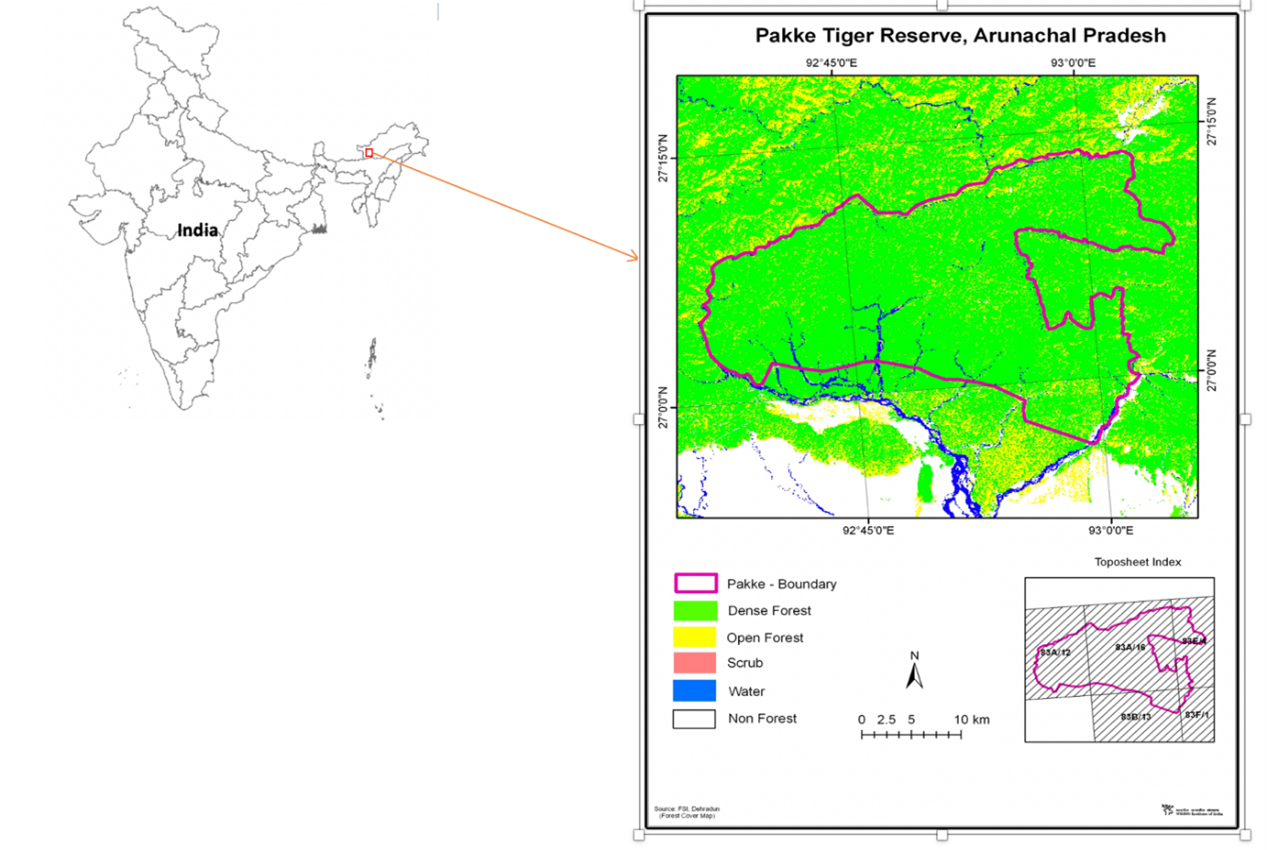
METHODS
The survey was conducted in March 2019. A total length of 6430 m of riverbank was surveyed, of which 2400 m were along the main river (Fig. 2) and 4030 m were along first order streams (Fig. 3), tributaries of the main river. We searched for otter sign (scat, latrine sites, tracks, dens). A combination of sign features, habitat preference, and behavior patterns were used to identify species. Scats and tracks were identified following characteristics described by Kruuk et al. (1993). The GPS location of each otter sign was recorded using Garmin eTrex 10. Each scat/latrine/track was examined carefully, and otter species identified based on size, shape, contents, and location of the sign. We also queried Forest Department staff and local inhabitants to collect more information about otters in Arunachal Pradesh.
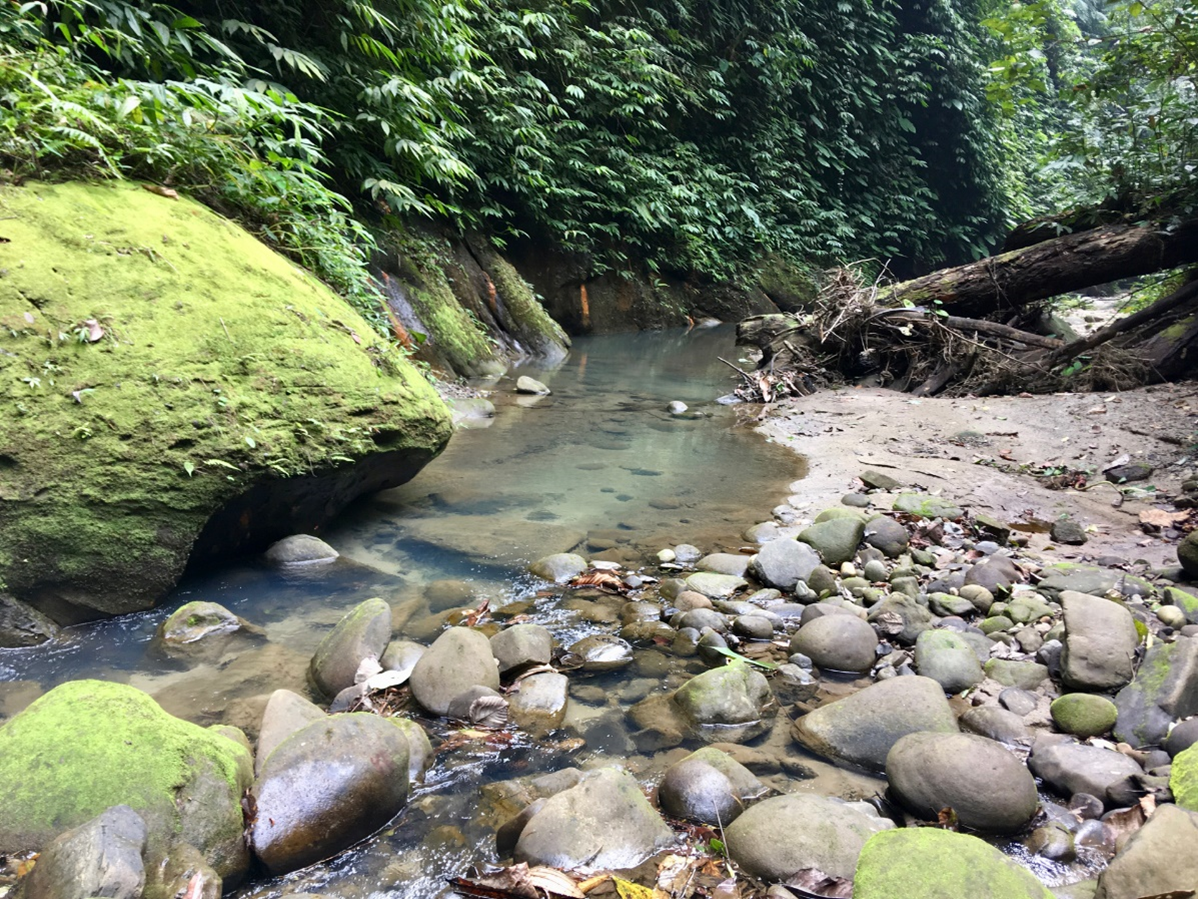
RESULTS
Based on size and composition of the scat and latrine sites, and their habitat type, elevation, and location, as well as interviews with the Forest Department staff, the presence in Pakke Tiger Reserve of two species of otter was confirmed, the Eurasian otter and the Small-clawed otter. A total of 43 signs were recorded over 6 days of the survey (Fig. 4). Scat and latrine sites were often found on large rocks or boulders along the water’s edge.
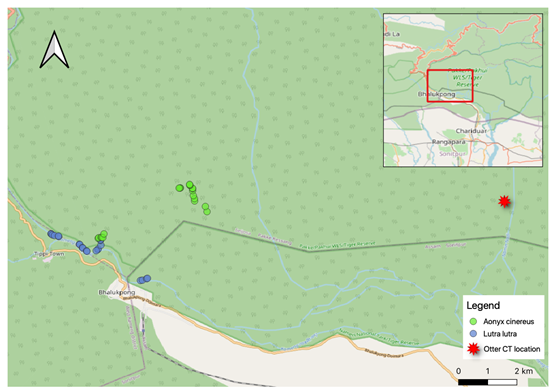
Among the signs recorded, we observed tracks of Eurasian otter, displaying distinct claw marks. In contrast, tracks of the Small-clawed otter are small with longer toes and lack distinct claw marks. The tracks of Smooth-coated otter are generally larger than those of either of these two species. The substrate on which the tracks were recorded could not conclusively rule out Smooth-coated otters, but further investigation would be needed to confirm the presence of this third otter species in the area.
We recorded scat from both of these otter species. Eurasian otter scat had a distinctly fishy odor and were larger in size than that of the Small-clawed otter (see Fig. 5). Scat of the Small-clawed otters consisted mostly of crustacean remains and were comparatively narrower. Based on these differences, 23 of the 43 signs recorded were identified as those of the Eurasian otter, and 20 as those of the Small-clawed otter.
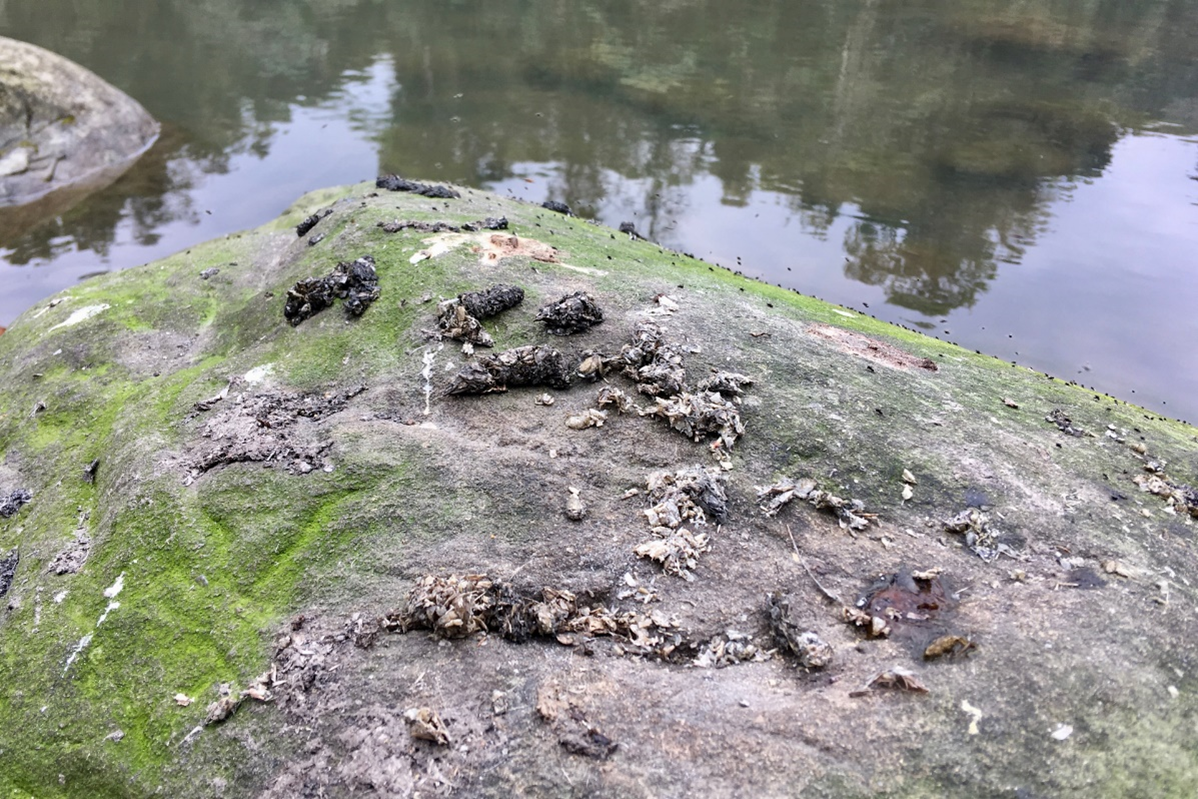
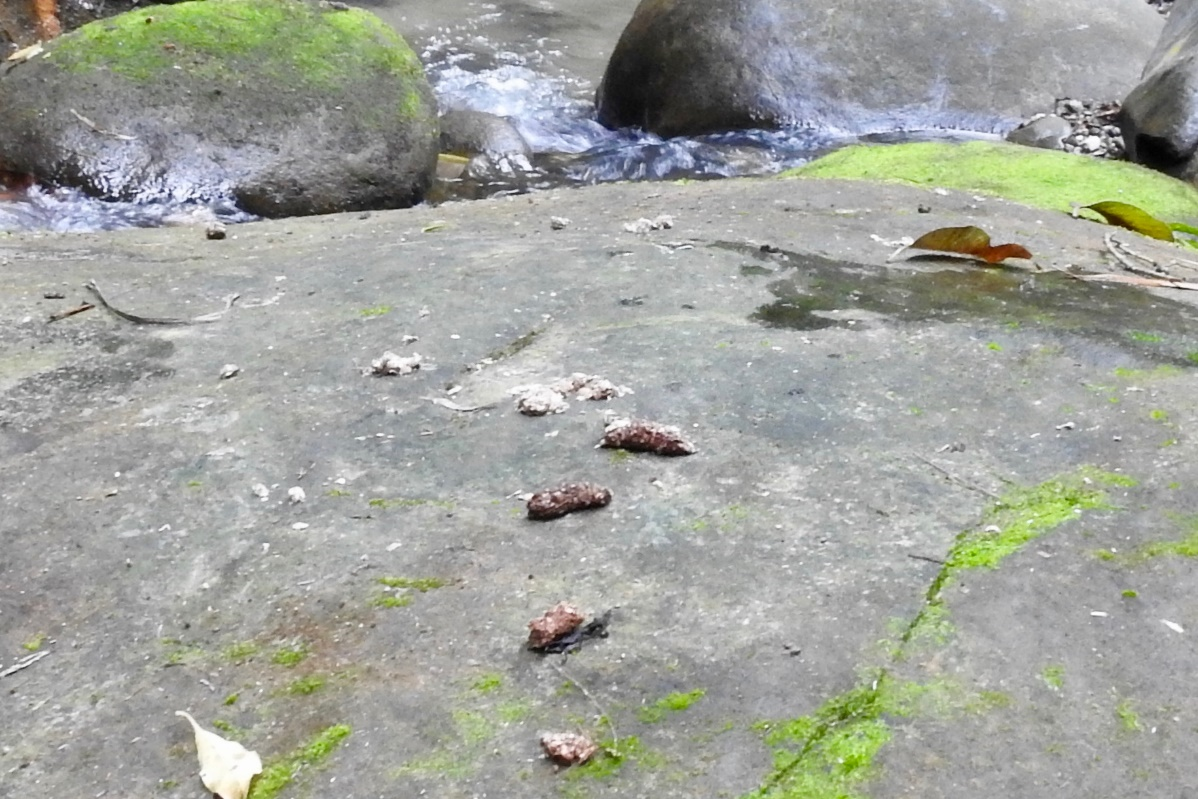
The Forest Department staff stated that they were aware of the presence of two different types of otters in Pakke Tiger Reserve, although they were unable to identify the species. They observed that one species was noticeably larger in size than the other. We retrieved a camera trap photo from 2015 that recorded a Small-clawed otter in the reserve in the Forest Department archive (Fig. 6). We also obtained a photo of a Eurasian otter from a local resident in nearby Shergaon, West Kameng (Fig. 7).
DISCUSSION
Although Arunachal Pradesh and Pakke Tiger Reserve have extensive suitable habitat for otters, this is the first field survey focused on otters in the region. We found survey-based and photographic evidence of two otter species present in the Reserve, the Eurasian otter and the Small-clawed otter. The different food and habitat preferences of each species likely facilitates co-existence. Although the two species of otter have been observed to overlap to some extent in their use of habitat, Small-clawed otters have been observed to prefer smaller rivers and streams in proximity to larger species of otter such as the Smooth-coated otter or the Hairy-nosed otter (Larivière, 2003). Similarly, we observed Eurasian otter scat and latrines along the main stretch of the river, while those of Small-clawed otters were primarily found along the smaller first and second order streams.
Otter populations are decreasing throughout the Himalayan region due to habitat fragmentation, poaching, contamination of waterways, reclamation of wetlands and construction of hydro power plants (Kafle, 2009; de Silva et al., 2015; Duplaix and Savage, 2018). Otters in Pakke Tiger Reserve and elsewhere in Arunachal Pradesh are highly threatened by commercial poaching for their valuable pelts, both by local tribal people and traders from Myanmar, and likely trafficked across international borders to Myanmar (Datta et al., 2008).
It is imperative that we understand the distribution and status of otters in Arunachal Pradesh so that informed conservation decisions can be made. Lack of such information will hinder suitable conservation efforts and lead to further declines in their populations. Presence/absence data is crucial for developing a species protection strategy. This study has laid a foundation for further long-term research on otter species in North-east India, to better understand otter distribution, status, and threats in this biodiverse region of India and to plan for their conservation.
Acknowledgements: We would like to thank the Arunachal Pradesh Forest Department, PCCF Dr. Rabindra Kumar IFS, DFO Tana Tapi, RFO Kime Rambia Pakke WLS, Chandan Ri, Forest Rangers at Bhalukpong, Tippi and Python anti-poaching camps, Nandini Velho, DK Thungon, Himalayan Otter Network and IUCN/SSC Otter Specialist Group for their support and assistance during the project. Funding was provided by the Himalayan Otter Network of the IUCN Otter Specialist Group.
REFERENCES
Bhattacharya, M., Watham, T., Gopi, G.V. (2019). Photographic Records of Eurasian Otter (Lutra lutra Linnaeus, 1758) from Nyamjang Chu River, Arunachal Pradesh, India. IUCN Otter Spec. Group Bull. 36(2): 103-109.
Champion, H.G., Seth, S.K. (1968). A revised survey of the forest types of India. Manager of Publications, Government of India, New Delhi.
Chettri, P., Savage, M. (2014). A Distribution Survey for Otters along a River in Central Bhutan. IUCN Otter Spec. Group Bull. 31(2): 65-74
Choudhury, A. (2013). The Mammals of North East India. Gibbon Books and the Rhino Foundation for Nature, Guwahati, India.
Conroy, J., Melisch, R., Chanin, P. (1998). The Distribution and Status of the Eurasian Otter (Lutra lutra) in Asia - a Preliminary Review. IUCN Otter Spec. Group Bull. 15(1): 15-30.
Das, N., Biswas, J., Bhattacharya, K., Nekaris, K.A.I. (2016). Observations on the Bengal slow loris Nycticebus bengalensis in Pakke Tiger Reserve, Arunachal Pradesh, India. Asian Primates J. 6(1): 27-32.
Datta, A., Naniwadekar, R., Anand, M.O. (2008). Occurrence and conservation status of small carnivores in two protected areas in Arunachal Pradesh, north-east India. Small Carniv. Conserv. 39: 1-10.
de Silva, P., Khan, W.A., Kanchanasaka, B., Reza Lubis, I., Feeroz, M.M., Al-Sheikhly, O.F. (2015). Lutrogale perspicillata. The IUCN Red List of Threatened Species 2015: e.T12427A21934884. https://dx.doi.org/10.2305/IUCN.UK.2015-2.RLTS.T12427A21934 884.en. Accessed on 10 February 2021.
Dhar, O.N., Nandargi, S. (2004). Rainfall distribution over the Arunachal Pradesh Himalayas. Weather. 59(6): 155-157.
Duplaix, N., Savage, M. (2018). The Global Otter Conservation Strategy. IUCN/SSC Otter Specialist Group, Salem, Oregon, USA.
Government of Arunachal Pradesh. (2019). Bio Diversity-Arunachal Pradesh. https://www.arunachalpradesh.gov.in/bio-diversity/, Accessed on 14 February 2021.
Gupta, N., Tiwari, V., Everard, M., Savage, M., Chadwick, M.A., Johnson, J.A., Nawab, A., Belwal, V.K. (2020). Assessing the distribution pattern of otters in four rivers of the Indian Himalayan biodiversity hotspot. Aquatic Conservation 30(3): 601-610. https://doi.org/10.1002/aqc.3284
Hussain, S.A. (1999). Status of Otter Conservation in India. Envis Bulletin: Wildlife and Protected Areas. 2(2): 92-97.
Hussain, S.A. (2002). Conservation status of otters in the Tarai and Lower Himalayas of Uttar Pradesh, India. In: Otter Conservation-An example for a sustainable use of wetlands. IUCN Otter Spec Group Bull: Proceedings from VIIth International Colloquium, Trebon, Czech Republic.19A: 131-142. https://www.iucnosgbull.org/Volume19A/Trebon-II.pdf.
Hussain, S.A. (2013). Otters. In: Johnsingh, A.J.T., Manjrekar, N. (eds.). Mammals of South Asia. Vol. 1. Universities Press, India, pp. 499-521.
Jamwal, P.S., Takpa, J., Chandan, P., Savage, M. (2016). First systematic survey for otter (Lutra lutra) in Ladakh, Indian Trans Himalayas. IUCN Otter Spec. Group Bull. 33(1): 79-85.
Joshi, A.S., Tumsare, V.M., Nagar, A.K., Mishra, A.K., Pariwakam, M.P. (2016). Photographic records of Eurasian Otter Lutra lutra from the central Indian landscape. IUCN Otter Spec. Group Bull. 33(2): 73-78.
Kafle, G. (2009). A Review on Research and Conservation of Otters in Nepal. IUCN Otter Spec. Group Bull. 26(1): 32-43.
Khatiwara, S., Bhutia, K.C. (2020). A Distribution Survey for Otters in Sikkim, India. IUCN Otter Spec. Group Bull. 37(4): 212-218.
Khound, N.J., Bhattacharyya, K.G. (2017). Multivariate statistical evaluation of heavy metals in the surface water sources of Jia Bharali River basin, North Brahmaputra plain, India. Appl. Water Sci. 7(5): 2577-2586.
Krupa, H., Borker, A. Gopal, A. (2017). Photographic Record of Sympatry between Asian Small-Clawed Otter and Smooth-Coated Otter in the Northern Western Ghats, India. IUCN Otter Spec. Group Bull. 34(1): 51-57.
Kruuk, H., Kanchanasaka, B., O'Sullivan, S., Wanghongsa, S. (1993). Identification of tracks and other sign of three species of otter, Lutra lutra, L. perspicillata and Aonyx cinerea, in Thailand. Nat. Hist. Siam Soc. 41: 23-30.
Larivière, S. (2003). Amblonyx cinereus. Mamm. Species. 720: 1-5.
Medhi, K., Chakraborty, R., Upadhyay, J. (2014). Photographic Record of Smooth-Coated Otter (Lutrogale perspicillata Geoffroy 1826) in Nyamjang Chu Valley, Arunachal Pradesh, India. IUCN Otter Spec. Group Bull. 31(2): 75-79.
Naniwadekar, R., Datta, A. (2013). Spatial and temporal variation in hornbill densities in Namdapha Tiger Reserve, Arunachal Pradesh, North-east India. Trop. Conserv. Sci. 6(6): 734-748.
Naniwadekar, R., Shukla, U., Viswanathan, A., Datta, A. (2013). Records of small carnivores from in and around Namdapha Tiger Reserve, Arunachal Pradesh, India. Small Carniv. Conserv. 49: 1-8.
Prakash, N., Mudappa, D., Raman, T. S., Kumar, A. (2012). Conservation of the Asian small-clawed otter (Aonyx cinereus) in human-modified landscapes, Western Ghats, India. Trop. Conserv. Sci. 5(1): 67-78.
Raha, A., Hussain, S.A. (2016). Factors affecting habitat selection by three sympatric otter species in the southern Western Ghats, India. Acta Ecologica Sinica. 36(1): 45-49.
Selvan, M., Lyngdoh, S., Gopi, G.V., Habib, B. (2014). Density estimation of leopard cat Prionailurus bengalensis using capture-recaptures sampling in lowland forest of Pakke Tiger Reserve, Arunachal Pradesh, India. Mammalia 78(4): 555-559.
Sharma, U., Shukla, S., Sinha, P., Purohit, R., Majumdar, A., Rai, A. (2014). Occurrence of Asian small-clawed otter Aonyx cinereus (Illiger, 1815) in Eastern India. Current Sci. 107(3): 367-370.
Résumé: Suivi des Loutres dans la Réserve de Pakke Tiger, Etat d’Arunachal Pradesh, dans l’Est de l’Himalaya en Inde
Les espèces de loutres sont en déclin dans leur distribution en Asie du Sud. Il y a un besoin urgent de comprendre la répartition des loutres dans la région, ainsi que d'orienter les efforts de conservation et de protéger leur habitat. En Inde, il existe très peu de données sur les loutres dans la région Nord-Est du pays. Dans cette étude, nous indiquons la présence de deux espèces : la loutre eurasienne (Lutra lutra) et la loutre cendrée (Aonyx cinereus), dans la réserve de Pakke Tiger et sanctuaire de faune situé dans l'Arunachal Pradesh, un grand État indien de l'Himalaya oriental. La loutre eurasienne et la loutre cendrée sont deux espèces inscrites à l'Annexe I de la CITES et sont protégées par le Wildlife (Protection) Act de 1972 en Inde. Nous avons mené un premier inventaire sur les loutres dans le Nord-Est de l'Inde, le long de la rivière Kameng, et avons enregistré 43 indices de présence de loutre, dont 23 de loutre eurasienne et 20 de loutre cendrée, et récupéré des enregistrements photographiques des deux espèces. Il est urgent de poursuivre les recherches et de développer des stratégies de conservation pour protéger les loutres dans cette région.
Revenez au dessus
Resumen: Relevamiento de Nutrias en la Reserva de Tigres Pakke, Arunachal Pradesh, Himalayas Orientales de India
Las especies de nutria están declinando en toda su distribución en el Sur de Asia. Hay una necesidad urgente de comprender la distribución de las nutrias en esta región, así como de dirigir esfuerzos de conservación y proteger su hábitat. En India, hay muy pocos datos sobre nutrias en la región Noreste del país. En este estudio, reportamos la presencia de dos especies, la Nutria Eurasiática y la Nutria de Uñas Pequeñas Asiática, en la Reserva de Tigres y Santuario de Vida Silvestre Pakke (referidos como Reserva de Tigres Pakke) en Arunachal Pradesh, un gran estadio de India en los Himalayas orientales. La Nutria Eurasiática y la Nutria de Uñas Pequeñas Asiática están listadas en el Apéndice I del CITES y están protegidas por la Ley de (Protección de la) Fauna de 1972, en India. Condujimos el primer relevamiento que se hace de nutrias en el Noreste de India, a lo largo del Río Kameng, y registramos 43 signos de nutria, 23 de la Nutria Eurasiática y 20 de la de Uñas Pequeñas, y obtuvimos registros fotográficos de ambas especies. Hay una urgente necesidad de realizar más investigaciones, y desarrollar las estrategias de conservación para proteger las nutrias de esta región.
Vuelva a la tapa

